Organizational Leadership: Analyzing Four Research Articles
VerifiedAdded on 2021/12/20
|17
|4194
|64
Essay
AI Summary
This essay delves into the multifaceted realm of organizational leadership, analyzing its significance and impact on business performance. It examines four research articles, comparing and contrasting different leadership styles, including ethical, transformational, and transactional approaches. The essay explores how leadership influences employee motivation, decision-making, and overall organizational effectiveness. The literature review highlights the strengths and weaknesses of each leadership approach, addressing issues such as resistance to change, the importance of ethical behavior, and the role of leaders in fostering innovation. The analysis emphasizes the need for strategic insight, adaptability, and emotional intelligence in leaders, while also acknowledging the limitations and gaps in current research, such as the need for more studies on ethical leadership and its long-term effects. The essay concludes by underscoring the critical role of organizational leadership in driving business excellence and achieving organizational goals.
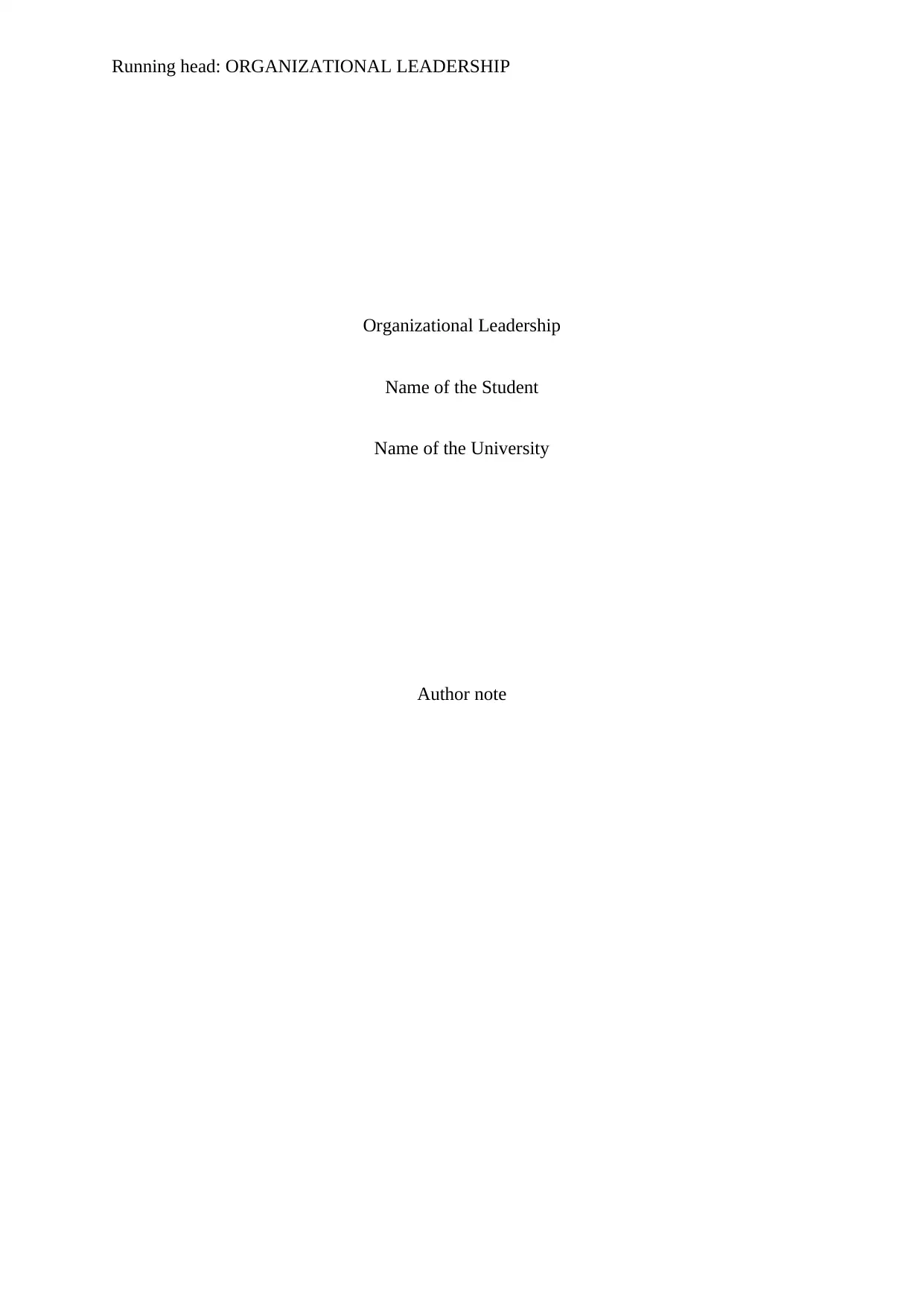
Running head: ORGANIZATIONAL LEADERSHIP
Organizational Leadership
Name of the Student
Name of the University
Author note
Organizational Leadership
Name of the Student
Name of the University
Author note
Paraphrase This Document
Need a fresh take? Get an instant paraphrase of this document with our AI Paraphraser
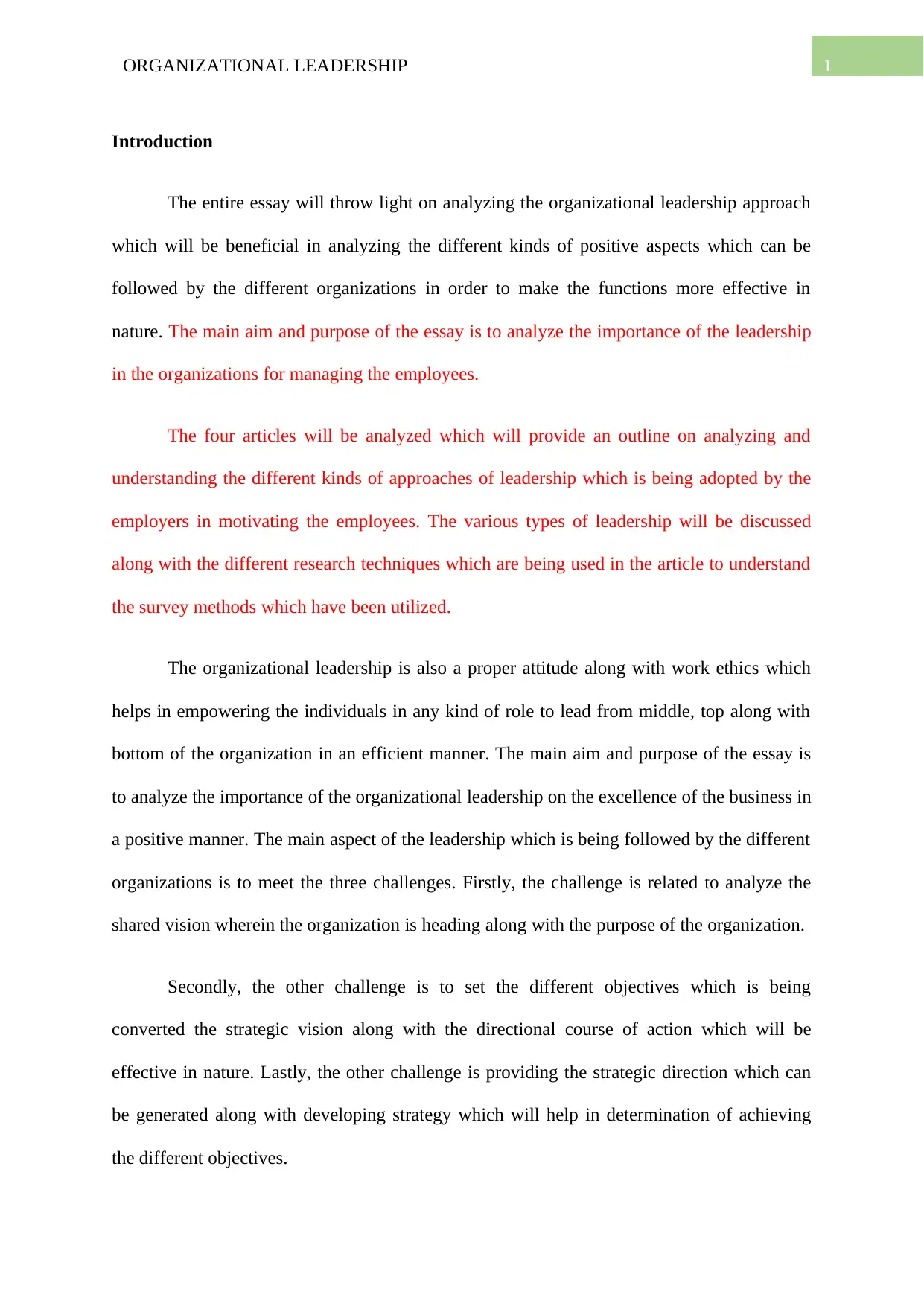
1ORGANIZATIONAL LEADERSHIP
Introduction
The entire essay will throw light on analyzing the organizational leadership approach
which will be beneficial in analyzing the different kinds of positive aspects which can be
followed by the different organizations in order to make the functions more effective in
nature. The main aim and purpose of the essay is to analyze the importance of the leadership
in the organizations for managing the employees.
The four articles will be analyzed which will provide an outline on analyzing and
understanding the different kinds of approaches of leadership which is being adopted by the
employers in motivating the employees. The various types of leadership will be discussed
along with the different research techniques which are being used in the article to understand
the survey methods which have been utilized.
The organizational leadership is also a proper attitude along with work ethics which
helps in empowering the individuals in any kind of role to lead from middle, top along with
bottom of the organization in an efficient manner. The main aim and purpose of the essay is
to analyze the importance of the organizational leadership on the excellence of the business in
a positive manner. The main aspect of the leadership which is being followed by the different
organizations is to meet the three challenges. Firstly, the challenge is related to analyze the
shared vision wherein the organization is heading along with the purpose of the organization.
Secondly, the other challenge is to set the different objectives which is being
converted the strategic vision along with the directional course of action which will be
effective in nature. Lastly, the other challenge is providing the strategic direction which can
be generated along with developing strategy which will help in determination of achieving
the different objectives.
Introduction
The entire essay will throw light on analyzing the organizational leadership approach
which will be beneficial in analyzing the different kinds of positive aspects which can be
followed by the different organizations in order to make the functions more effective in
nature. The main aim and purpose of the essay is to analyze the importance of the leadership
in the organizations for managing the employees.
The four articles will be analyzed which will provide an outline on analyzing and
understanding the different kinds of approaches of leadership which is being adopted by the
employers in motivating the employees. The various types of leadership will be discussed
along with the different research techniques which are being used in the article to understand
the survey methods which have been utilized.
The organizational leadership is also a proper attitude along with work ethics which
helps in empowering the individuals in any kind of role to lead from middle, top along with
bottom of the organization in an efficient manner. The main aim and purpose of the essay is
to analyze the importance of the organizational leadership on the excellence of the business in
a positive manner. The main aspect of the leadership which is being followed by the different
organizations is to meet the three challenges. Firstly, the challenge is related to analyze the
shared vision wherein the organization is heading along with the purpose of the organization.
Secondly, the other challenge is to set the different objectives which is being
converted the strategic vision along with the directional course of action which will be
effective in nature. Lastly, the other challenge is providing the strategic direction which can
be generated along with developing strategy which will help in determination of achieving
the different objectives.
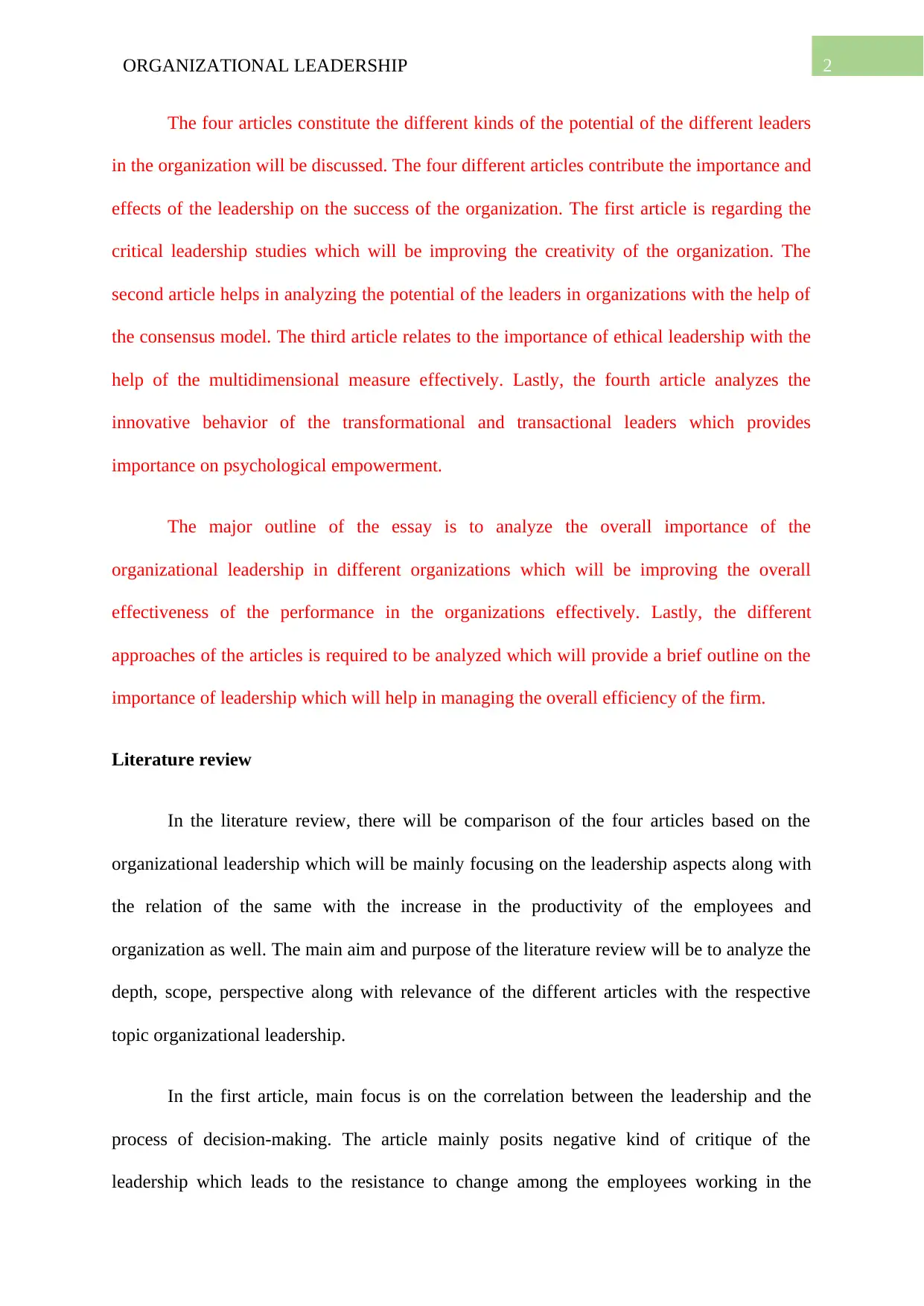
2ORGANIZATIONAL LEADERSHIP
The four articles constitute the different kinds of the potential of the different leaders
in the organization will be discussed. The four different articles contribute the importance and
effects of the leadership on the success of the organization. The first article is regarding the
critical leadership studies which will be improving the creativity of the organization. The
second article helps in analyzing the potential of the leaders in organizations with the help of
the consensus model. The third article relates to the importance of ethical leadership with the
help of the multidimensional measure effectively. Lastly, the fourth article analyzes the
innovative behavior of the transformational and transactional leaders which provides
importance on psychological empowerment.
The major outline of the essay is to analyze the overall importance of the
organizational leadership in different organizations which will be improving the overall
effectiveness of the performance in the organizations effectively. Lastly, the different
approaches of the articles is required to be analyzed which will provide a brief outline on the
importance of leadership which will help in managing the overall efficiency of the firm.
Literature review
In the literature review, there will be comparison of the four articles based on the
organizational leadership which will be mainly focusing on the leadership aspects along with
the relation of the same with the increase in the productivity of the employees and
organization as well. The main aim and purpose of the literature review will be to analyze the
depth, scope, perspective along with relevance of the different articles with the respective
topic organizational leadership.
In the first article, main focus is on the correlation between the leadership and the
process of decision-making. The article mainly posits negative kind of critique of the
leadership which leads to the resistance to change among the employees working in the
The four articles constitute the different kinds of the potential of the different leaders
in the organization will be discussed. The four different articles contribute the importance and
effects of the leadership on the success of the organization. The first article is regarding the
critical leadership studies which will be improving the creativity of the organization. The
second article helps in analyzing the potential of the leaders in organizations with the help of
the consensus model. The third article relates to the importance of ethical leadership with the
help of the multidimensional measure effectively. Lastly, the fourth article analyzes the
innovative behavior of the transformational and transactional leaders which provides
importance on psychological empowerment.
The major outline of the essay is to analyze the overall importance of the
organizational leadership in different organizations which will be improving the overall
effectiveness of the performance in the organizations effectively. Lastly, the different
approaches of the articles is required to be analyzed which will provide a brief outline on the
importance of leadership which will help in managing the overall efficiency of the firm.
Literature review
In the literature review, there will be comparison of the four articles based on the
organizational leadership which will be mainly focusing on the leadership aspects along with
the relation of the same with the increase in the productivity of the employees and
organization as well. The main aim and purpose of the literature review will be to analyze the
depth, scope, perspective along with relevance of the different articles with the respective
topic organizational leadership.
In the first article, main focus is on the correlation between the leadership and the
process of decision-making. The article mainly posits negative kind of critique of the
leadership which leads to the resistance to change among the employees working in the
⊘ This is a preview!⊘
Do you want full access?
Subscribe today to unlock all pages.

Trusted by 1+ million students worldwide
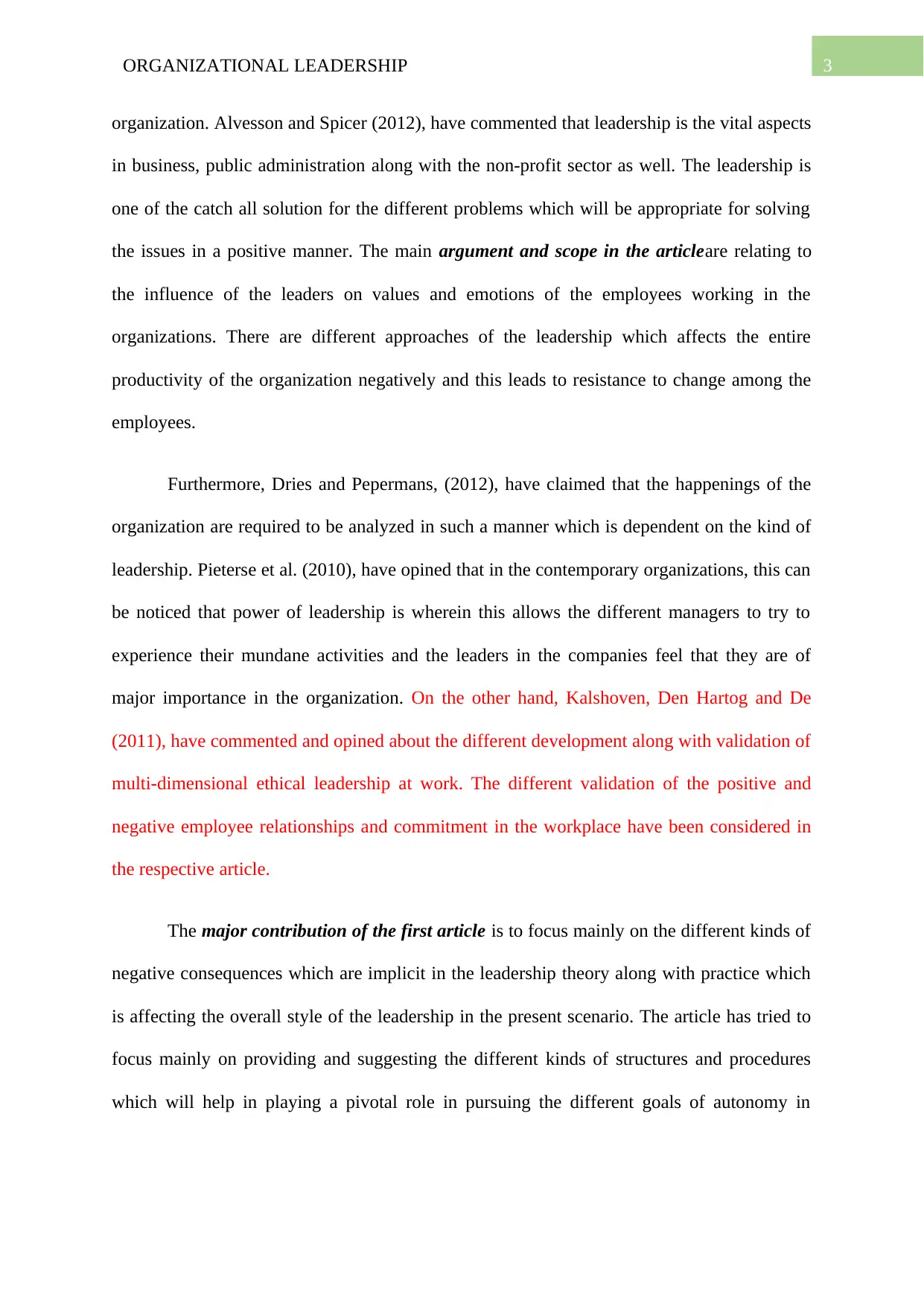
3ORGANIZATIONAL LEADERSHIP
organization. Alvesson and Spicer (2012), have commented that leadership is the vital aspects
in business, public administration along with the non-profit sector as well. The leadership is
one of the catch all solution for the different problems which will be appropriate for solving
the issues in a positive manner. The main argument and scope in the articleare relating to
the influence of the leaders on values and emotions of the employees working in the
organizations. There are different approaches of the leadership which affects the entire
productivity of the organization negatively and this leads to resistance to change among the
employees.
Furthermore, Dries and Pepermans, (2012), have claimed that the happenings of the
organization are required to be analyzed in such a manner which is dependent on the kind of
leadership. Pieterse et al. (2010), have opined that in the contemporary organizations, this can
be noticed that power of leadership is wherein this allows the different managers to try to
experience their mundane activities and the leaders in the companies feel that they are of
major importance in the organization. On the other hand, Kalshoven, Den Hartog and De
(2011), have commented and opined about the different development along with validation of
multi-dimensional ethical leadership at work. The different validation of the positive and
negative employee relationships and commitment in the workplace have been considered in
the respective article.
The major contribution of the first article is to focus mainly on the different kinds of
negative consequences which are implicit in the leadership theory along with practice which
is affecting the overall style of the leadership in the present scenario. The article has tried to
focus mainly on providing and suggesting the different kinds of structures and procedures
which will help in playing a pivotal role in pursuing the different goals of autonomy in
organization. Alvesson and Spicer (2012), have commented that leadership is the vital aspects
in business, public administration along with the non-profit sector as well. The leadership is
one of the catch all solution for the different problems which will be appropriate for solving
the issues in a positive manner. The main argument and scope in the articleare relating to
the influence of the leaders on values and emotions of the employees working in the
organizations. There are different approaches of the leadership which affects the entire
productivity of the organization negatively and this leads to resistance to change among the
employees.
Furthermore, Dries and Pepermans, (2012), have claimed that the happenings of the
organization are required to be analyzed in such a manner which is dependent on the kind of
leadership. Pieterse et al. (2010), have opined that in the contemporary organizations, this can
be noticed that power of leadership is wherein this allows the different managers to try to
experience their mundane activities and the leaders in the companies feel that they are of
major importance in the organization. On the other hand, Kalshoven, Den Hartog and De
(2011), have commented and opined about the different development along with validation of
multi-dimensional ethical leadership at work. The different validation of the positive and
negative employee relationships and commitment in the workplace have been considered in
the respective article.
The major contribution of the first article is to focus mainly on the different kinds of
negative consequences which are implicit in the leadership theory along with practice which
is affecting the overall style of the leadership in the present scenario. The article has tried to
focus mainly on providing and suggesting the different kinds of structures and procedures
which will help in playing a pivotal role in pursuing the different goals of autonomy in
Paraphrase This Document
Need a fresh take? Get an instant paraphrase of this document with our AI Paraphraser
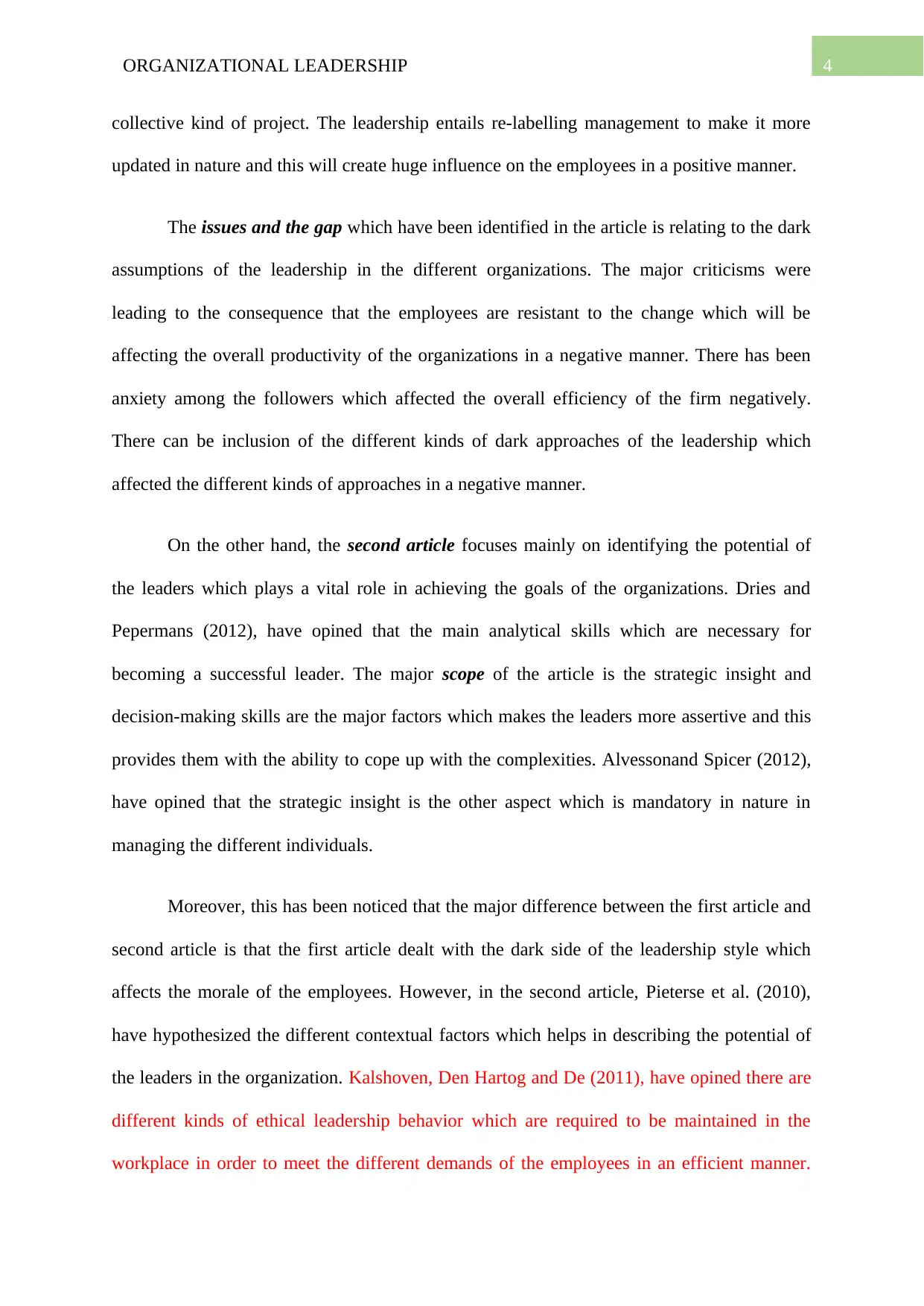
4ORGANIZATIONAL LEADERSHIP
collective kind of project. The leadership entails re-labelling management to make it more
updated in nature and this will create huge influence on the employees in a positive manner.
The issues and the gap which have been identified in the article is relating to the dark
assumptions of the leadership in the different organizations. The major criticisms were
leading to the consequence that the employees are resistant to the change which will be
affecting the overall productivity of the organizations in a negative manner. There has been
anxiety among the followers which affected the overall efficiency of the firm negatively.
There can be inclusion of the different kinds of dark approaches of the leadership which
affected the different kinds of approaches in a negative manner.
On the other hand, the second article focuses mainly on identifying the potential of
the leaders which plays a vital role in achieving the goals of the organizations. Dries and
Pepermans (2012), have opined that the main analytical skills which are necessary for
becoming a successful leader. The major scope of the article is the strategic insight and
decision-making skills are the major factors which makes the leaders more assertive and this
provides them with the ability to cope up with the complexities. Alvessonand Spicer (2012),
have opined that the strategic insight is the other aspect which is mandatory in nature in
managing the different individuals.
Moreover, this has been noticed that the major difference between the first article and
second article is that the first article dealt with the dark side of the leadership style which
affects the morale of the employees. However, in the second article, Pieterse et al. (2010),
have hypothesized the different contextual factors which helps in describing the potential of
the leaders in the organization. Kalshoven, Den Hartog and De (2011), have opined there are
different kinds of ethical leadership behavior which are required to be maintained in the
workplace in order to meet the different demands of the employees in an efficient manner.
collective kind of project. The leadership entails re-labelling management to make it more
updated in nature and this will create huge influence on the employees in a positive manner.
The issues and the gap which have been identified in the article is relating to the dark
assumptions of the leadership in the different organizations. The major criticisms were
leading to the consequence that the employees are resistant to the change which will be
affecting the overall productivity of the organizations in a negative manner. There has been
anxiety among the followers which affected the overall efficiency of the firm negatively.
There can be inclusion of the different kinds of dark approaches of the leadership which
affected the different kinds of approaches in a negative manner.
On the other hand, the second article focuses mainly on identifying the potential of
the leaders which plays a vital role in achieving the goals of the organizations. Dries and
Pepermans (2012), have opined that the main analytical skills which are necessary for
becoming a successful leader. The major scope of the article is the strategic insight and
decision-making skills are the major factors which makes the leaders more assertive and this
provides them with the ability to cope up with the complexities. Alvessonand Spicer (2012),
have opined that the strategic insight is the other aspect which is mandatory in nature in
managing the different individuals.
Moreover, this has been noticed that the major difference between the first article and
second article is that the first article dealt with the dark side of the leadership style which
affects the morale of the employees. However, in the second article, Pieterse et al. (2010),
have hypothesized the different contextual factors which helps in describing the potential of
the leaders in the organization. Kalshoven, Den Hartog and De (2011), have opined there are
different kinds of ethical leadership behavior which are required to be maintained in the
workplace in order to meet the different demands of the employees in an efficient manner.
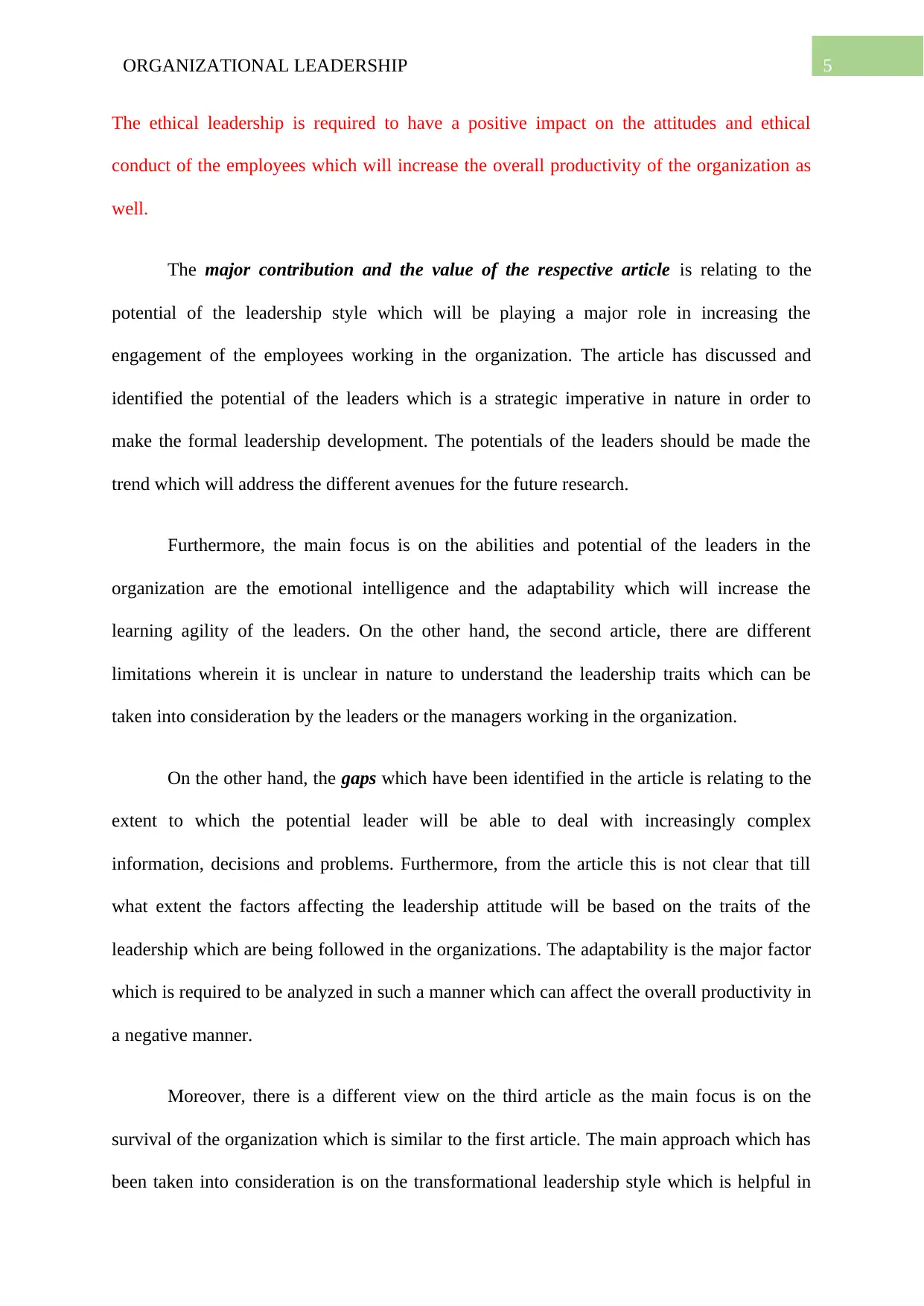
5ORGANIZATIONAL LEADERSHIP
The ethical leadership is required to have a positive impact on the attitudes and ethical
conduct of the employees which will increase the overall productivity of the organization as
well.
The major contribution and the value of the respective article is relating to the
potential of the leadership style which will be playing a major role in increasing the
engagement of the employees working in the organization. The article has discussed and
identified the potential of the leaders which is a strategic imperative in nature in order to
make the formal leadership development. The potentials of the leaders should be made the
trend which will address the different avenues for the future research.
Furthermore, the main focus is on the abilities and potential of the leaders in the
organization are the emotional intelligence and the adaptability which will increase the
learning agility of the leaders. On the other hand, the second article, there are different
limitations wherein it is unclear in nature to understand the leadership traits which can be
taken into consideration by the leaders or the managers working in the organization.
On the other hand, the gaps which have been identified in the article is relating to the
extent to which the potential leader will be able to deal with increasingly complex
information, decisions and problems. Furthermore, from the article this is not clear that till
what extent the factors affecting the leadership attitude will be based on the traits of the
leadership which are being followed in the organizations. The adaptability is the major factor
which is required to be analyzed in such a manner which can affect the overall productivity in
a negative manner.
Moreover, there is a different view on the third article as the main focus is on the
survival of the organization which is similar to the first article. The main approach which has
been taken into consideration is on the transformational leadership style which is helpful in
The ethical leadership is required to have a positive impact on the attitudes and ethical
conduct of the employees which will increase the overall productivity of the organization as
well.
The major contribution and the value of the respective article is relating to the
potential of the leadership style which will be playing a major role in increasing the
engagement of the employees working in the organization. The article has discussed and
identified the potential of the leaders which is a strategic imperative in nature in order to
make the formal leadership development. The potentials of the leaders should be made the
trend which will address the different avenues for the future research.
Furthermore, the main focus is on the abilities and potential of the leaders in the
organization are the emotional intelligence and the adaptability which will increase the
learning agility of the leaders. On the other hand, the second article, there are different
limitations wherein it is unclear in nature to understand the leadership traits which can be
taken into consideration by the leaders or the managers working in the organization.
On the other hand, the gaps which have been identified in the article is relating to the
extent to which the potential leader will be able to deal with increasingly complex
information, decisions and problems. Furthermore, from the article this is not clear that till
what extent the factors affecting the leadership attitude will be based on the traits of the
leadership which are being followed in the organizations. The adaptability is the major factor
which is required to be analyzed in such a manner which can affect the overall productivity in
a negative manner.
Moreover, there is a different view on the third article as the main focus is on the
survival of the organization which is similar to the first article. The main approach which has
been taken into consideration is on the transformational leadership style which is helpful in
⊘ This is a preview!⊘
Do you want full access?
Subscribe today to unlock all pages.

Trusted by 1+ million students worldwide
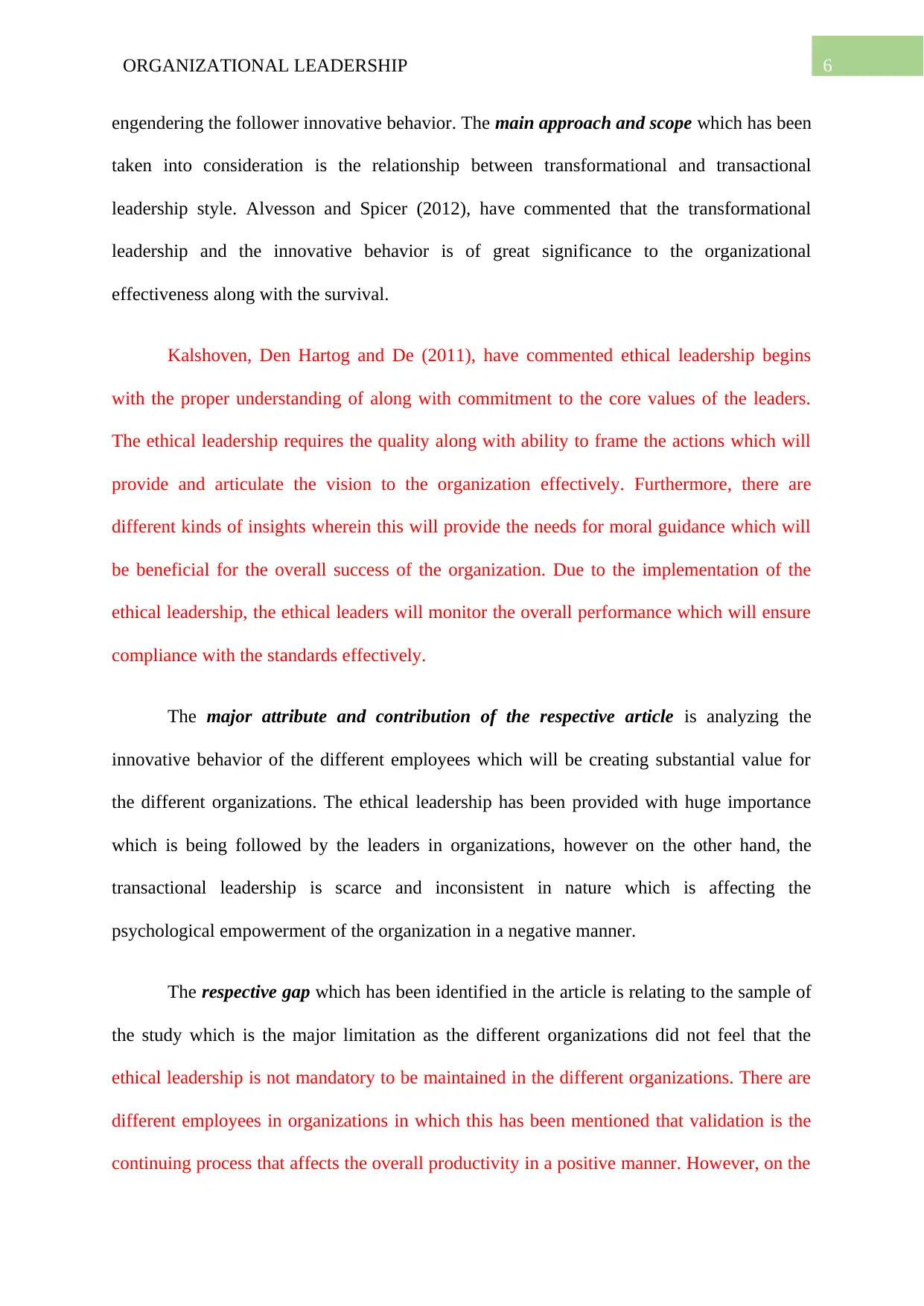
6ORGANIZATIONAL LEADERSHIP
engendering the follower innovative behavior. The main approach and scope which has been
taken into consideration is the relationship between transformational and transactional
leadership style. Alvesson and Spicer (2012), have commented that the transformational
leadership and the innovative behavior is of great significance to the organizational
effectiveness along with the survival.
Kalshoven, Den Hartog and De (2011), have commented ethical leadership begins
with the proper understanding of along with commitment to the core values of the leaders.
The ethical leadership requires the quality along with ability to frame the actions which will
provide and articulate the vision to the organization effectively. Furthermore, there are
different kinds of insights wherein this will provide the needs for moral guidance which will
be beneficial for the overall success of the organization. Due to the implementation of the
ethical leadership, the ethical leaders will monitor the overall performance which will ensure
compliance with the standards effectively.
The major attribute and contribution of the respective article is analyzing the
innovative behavior of the different employees which will be creating substantial value for
the different organizations. The ethical leadership has been provided with huge importance
which is being followed by the leaders in organizations, however on the other hand, the
transactional leadership is scarce and inconsistent in nature which is affecting the
psychological empowerment of the organization in a negative manner.
The respective gap which has been identified in the article is relating to the sample of
the study which is the major limitation as the different organizations did not feel that the
ethical leadership is not mandatory to be maintained in the different organizations. There are
different employees in organizations in which this has been mentioned that validation is the
continuing process that affects the overall productivity in a positive manner. However, on the
engendering the follower innovative behavior. The main approach and scope which has been
taken into consideration is the relationship between transformational and transactional
leadership style. Alvesson and Spicer (2012), have commented that the transformational
leadership and the innovative behavior is of great significance to the organizational
effectiveness along with the survival.
Kalshoven, Den Hartog and De (2011), have commented ethical leadership begins
with the proper understanding of along with commitment to the core values of the leaders.
The ethical leadership requires the quality along with ability to frame the actions which will
provide and articulate the vision to the organization effectively. Furthermore, there are
different kinds of insights wherein this will provide the needs for moral guidance which will
be beneficial for the overall success of the organization. Due to the implementation of the
ethical leadership, the ethical leaders will monitor the overall performance which will ensure
compliance with the standards effectively.
The major attribute and contribution of the respective article is analyzing the
innovative behavior of the different employees which will be creating substantial value for
the different organizations. The ethical leadership has been provided with huge importance
which is being followed by the leaders in organizations, however on the other hand, the
transactional leadership is scarce and inconsistent in nature which is affecting the
psychological empowerment of the organization in a negative manner.
The respective gap which has been identified in the article is relating to the sample of
the study which is the major limitation as the different organizations did not feel that the
ethical leadership is not mandatory to be maintained in the different organizations. There are
different employees in organizations in which this has been mentioned that validation is the
continuing process that affects the overall productivity in a positive manner. However, on the
Paraphrase This Document
Need a fresh take? Get an instant paraphrase of this document with our AI Paraphraser
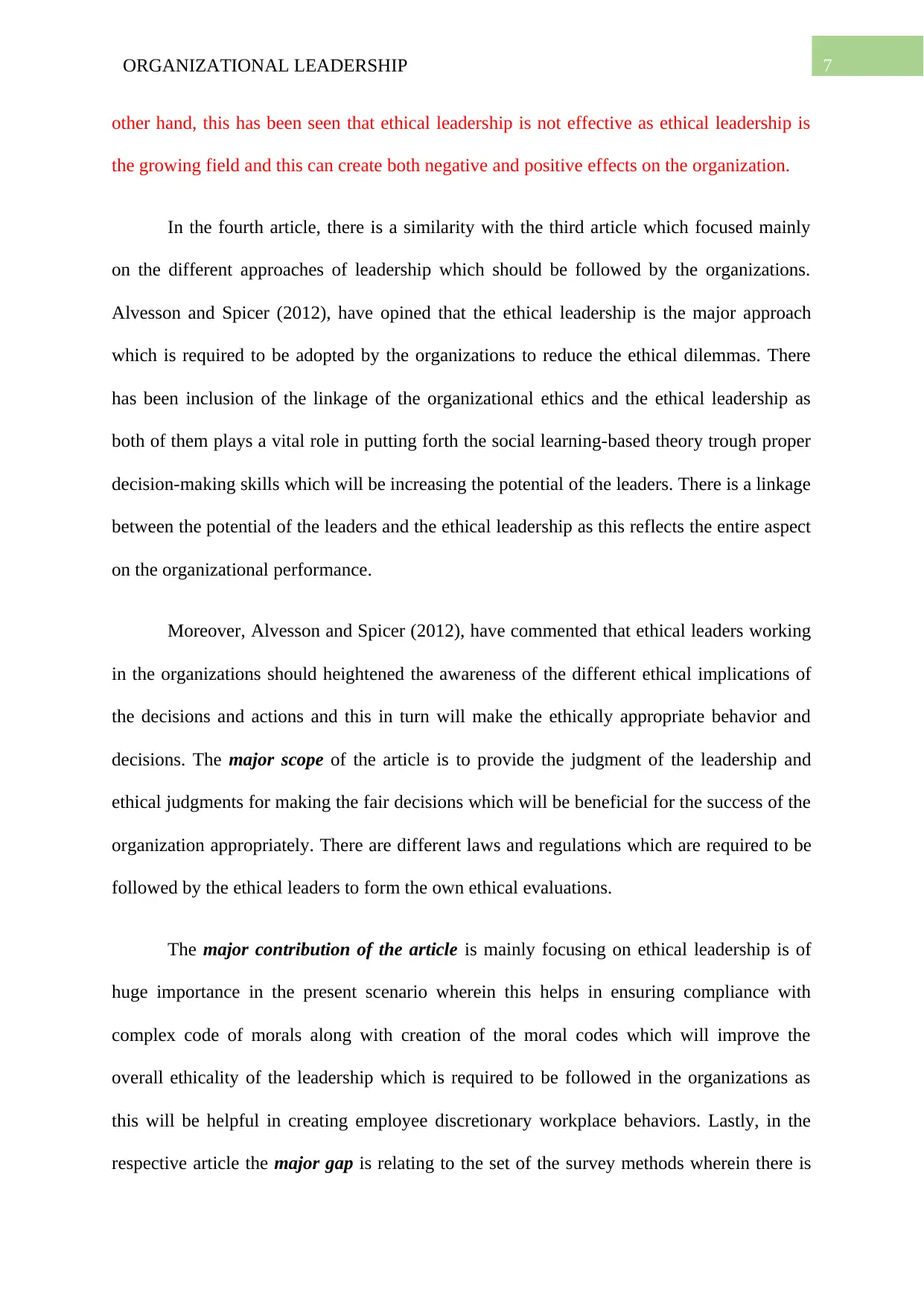
7ORGANIZATIONAL LEADERSHIP
other hand, this has been seen that ethical leadership is not effective as ethical leadership is
the growing field and this can create both negative and positive effects on the organization.
In the fourth article, there is a similarity with the third article which focused mainly
on the different approaches of leadership which should be followed by the organizations.
Alvesson and Spicer (2012), have opined that the ethical leadership is the major approach
which is required to be adopted by the organizations to reduce the ethical dilemmas. There
has been inclusion of the linkage of the organizational ethics and the ethical leadership as
both of them plays a vital role in putting forth the social learning-based theory trough proper
decision-making skills which will be increasing the potential of the leaders. There is a linkage
between the potential of the leaders and the ethical leadership as this reflects the entire aspect
on the organizational performance.
Moreover, Alvesson and Spicer (2012), have commented that ethical leaders working
in the organizations should heightened the awareness of the different ethical implications of
the decisions and actions and this in turn will make the ethically appropriate behavior and
decisions. The major scope of the article is to provide the judgment of the leadership and
ethical judgments for making the fair decisions which will be beneficial for the success of the
organization appropriately. There are different laws and regulations which are required to be
followed by the ethical leaders to form the own ethical evaluations.
The major contribution of the article is mainly focusing on ethical leadership is of
huge importance in the present scenario wherein this helps in ensuring compliance with
complex code of morals along with creation of the moral codes which will improve the
overall ethicality of the leadership which is required to be followed in the organizations as
this will be helpful in creating employee discretionary workplace behaviors. Lastly, in the
respective article the major gap is relating to the set of the survey methods wherein there is
other hand, this has been seen that ethical leadership is not effective as ethical leadership is
the growing field and this can create both negative and positive effects on the organization.
In the fourth article, there is a similarity with the third article which focused mainly
on the different approaches of leadership which should be followed by the organizations.
Alvesson and Spicer (2012), have opined that the ethical leadership is the major approach
which is required to be adopted by the organizations to reduce the ethical dilemmas. There
has been inclusion of the linkage of the organizational ethics and the ethical leadership as
both of them plays a vital role in putting forth the social learning-based theory trough proper
decision-making skills which will be increasing the potential of the leaders. There is a linkage
between the potential of the leaders and the ethical leadership as this reflects the entire aspect
on the organizational performance.
Moreover, Alvesson and Spicer (2012), have commented that ethical leaders working
in the organizations should heightened the awareness of the different ethical implications of
the decisions and actions and this in turn will make the ethically appropriate behavior and
decisions. The major scope of the article is to provide the judgment of the leadership and
ethical judgments for making the fair decisions which will be beneficial for the success of the
organization appropriately. There are different laws and regulations which are required to be
followed by the ethical leaders to form the own ethical evaluations.
The major contribution of the article is mainly focusing on ethical leadership is of
huge importance in the present scenario wherein this helps in ensuring compliance with
complex code of morals along with creation of the moral codes which will improve the
overall ethicality of the leadership which is required to be followed in the organizations as
this will be helpful in creating employee discretionary workplace behaviors. Lastly, in the
respective article the major gap is relating to the set of the survey methods wherein there is
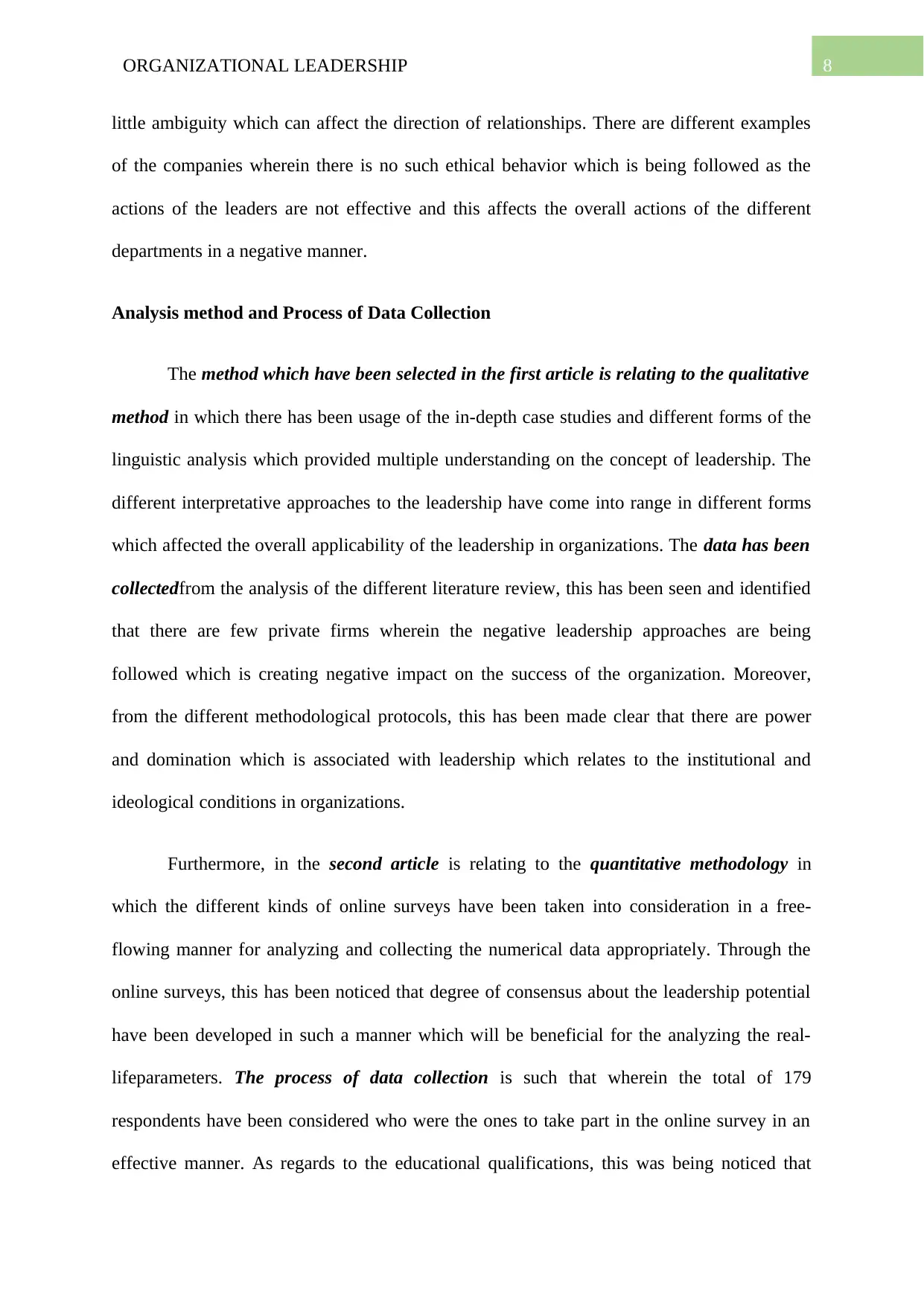
8ORGANIZATIONAL LEADERSHIP
little ambiguity which can affect the direction of relationships. There are different examples
of the companies wherein there is no such ethical behavior which is being followed as the
actions of the leaders are not effective and this affects the overall actions of the different
departments in a negative manner.
Analysis method and Process of Data Collection
The method which have been selected in the first article is relating to the qualitative
method in which there has been usage of the in-depth case studies and different forms of the
linguistic analysis which provided multiple understanding on the concept of leadership. The
different interpretative approaches to the leadership have come into range in different forms
which affected the overall applicability of the leadership in organizations. The data has been
collectedfrom the analysis of the different literature review, this has been seen and identified
that there are few private firms wherein the negative leadership approaches are being
followed which is creating negative impact on the success of the organization. Moreover,
from the different methodological protocols, this has been made clear that there are power
and domination which is associated with leadership which relates to the institutional and
ideological conditions in organizations.
Furthermore, in the second article is relating to the quantitative methodology in
which the different kinds of online surveys have been taken into consideration in a free-
flowing manner for analyzing and collecting the numerical data appropriately. Through the
online surveys, this has been noticed that degree of consensus about the leadership potential
have been developed in such a manner which will be beneficial for the analyzing the real-
lifeparameters. The process of data collection is such that wherein the total of 179
respondents have been considered who were the ones to take part in the online survey in an
effective manner. As regards to the educational qualifications, this was being noticed that
little ambiguity which can affect the direction of relationships. There are different examples
of the companies wherein there is no such ethical behavior which is being followed as the
actions of the leaders are not effective and this affects the overall actions of the different
departments in a negative manner.
Analysis method and Process of Data Collection
The method which have been selected in the first article is relating to the qualitative
method in which there has been usage of the in-depth case studies and different forms of the
linguistic analysis which provided multiple understanding on the concept of leadership. The
different interpretative approaches to the leadership have come into range in different forms
which affected the overall applicability of the leadership in organizations. The data has been
collectedfrom the analysis of the different literature review, this has been seen and identified
that there are few private firms wherein the negative leadership approaches are being
followed which is creating negative impact on the success of the organization. Moreover,
from the different methodological protocols, this has been made clear that there are power
and domination which is associated with leadership which relates to the institutional and
ideological conditions in organizations.
Furthermore, in the second article is relating to the quantitative methodology in
which the different kinds of online surveys have been taken into consideration in a free-
flowing manner for analyzing and collecting the numerical data appropriately. Through the
online surveys, this has been noticed that degree of consensus about the leadership potential
have been developed in such a manner which will be beneficial for the analyzing the real-
lifeparameters. The process of data collection is such that wherein the total of 179
respondents have been considered who were the ones to take part in the online survey in an
effective manner. As regards to the educational qualifications, this was being noticed that
⊘ This is a preview!⊘
Do you want full access?
Subscribe today to unlock all pages.

Trusted by 1+ million students worldwide
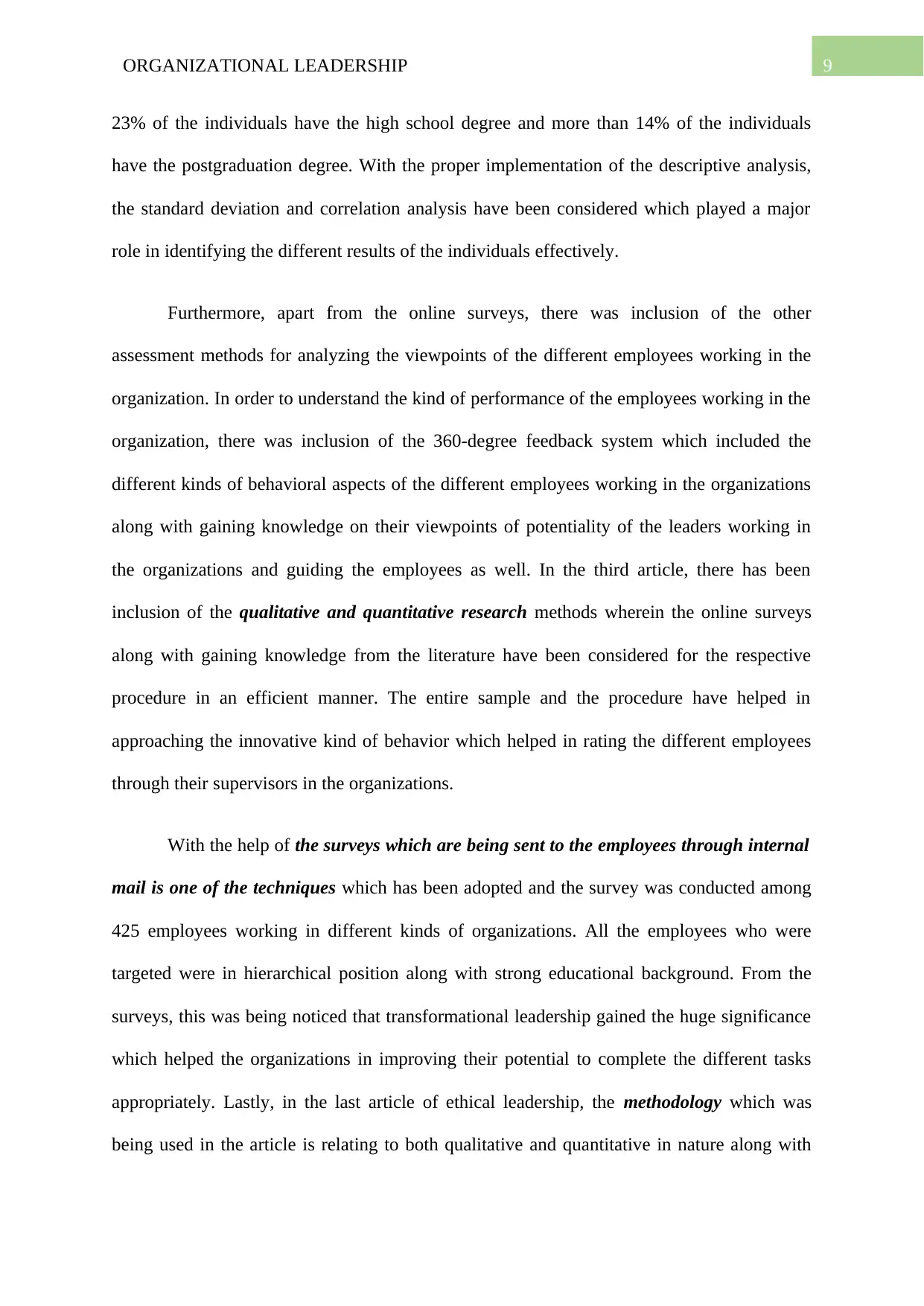
9ORGANIZATIONAL LEADERSHIP
23% of the individuals have the high school degree and more than 14% of the individuals
have the postgraduation degree. With the proper implementation of the descriptive analysis,
the standard deviation and correlation analysis have been considered which played a major
role in identifying the different results of the individuals effectively.
Furthermore, apart from the online surveys, there was inclusion of the other
assessment methods for analyzing the viewpoints of the different employees working in the
organization. In order to understand the kind of performance of the employees working in the
organization, there was inclusion of the 360-degree feedback system which included the
different kinds of behavioral aspects of the different employees working in the organizations
along with gaining knowledge on their viewpoints of potentiality of the leaders working in
the organizations and guiding the employees as well. In the third article, there has been
inclusion of the qualitative and quantitative research methods wherein the online surveys
along with gaining knowledge from the literature have been considered for the respective
procedure in an efficient manner. The entire sample and the procedure have helped in
approaching the innovative kind of behavior which helped in rating the different employees
through their supervisors in the organizations.
With the help of the surveys which are being sent to the employees through internal
mail is one of the techniques which has been adopted and the survey was conducted among
425 employees working in different kinds of organizations. All the employees who were
targeted were in hierarchical position along with strong educational background. From the
surveys, this was being noticed that transformational leadership gained the huge significance
which helped the organizations in improving their potential to complete the different tasks
appropriately. Lastly, in the last article of ethical leadership, the methodology which was
being used in the article is relating to both qualitative and quantitative in nature along with
23% of the individuals have the high school degree and more than 14% of the individuals
have the postgraduation degree. With the proper implementation of the descriptive analysis,
the standard deviation and correlation analysis have been considered which played a major
role in identifying the different results of the individuals effectively.
Furthermore, apart from the online surveys, there was inclusion of the other
assessment methods for analyzing the viewpoints of the different employees working in the
organization. In order to understand the kind of performance of the employees working in the
organization, there was inclusion of the 360-degree feedback system which included the
different kinds of behavioral aspects of the different employees working in the organizations
along with gaining knowledge on their viewpoints of potentiality of the leaders working in
the organizations and guiding the employees as well. In the third article, there has been
inclusion of the qualitative and quantitative research methods wherein the online surveys
along with gaining knowledge from the literature have been considered for the respective
procedure in an efficient manner. The entire sample and the procedure have helped in
approaching the innovative kind of behavior which helped in rating the different employees
through their supervisors in the organizations.
With the help of the surveys which are being sent to the employees through internal
mail is one of the techniques which has been adopted and the survey was conducted among
425 employees working in different kinds of organizations. All the employees who were
targeted were in hierarchical position along with strong educational background. From the
surveys, this was being noticed that transformational leadership gained the huge significance
which helped the organizations in improving their potential to complete the different tasks
appropriately. Lastly, in the last article of ethical leadership, the methodology which was
being used in the article is relating to both qualitative and quantitative in nature along with
Paraphrase This Document
Need a fresh take? Get an instant paraphrase of this document with our AI Paraphraser
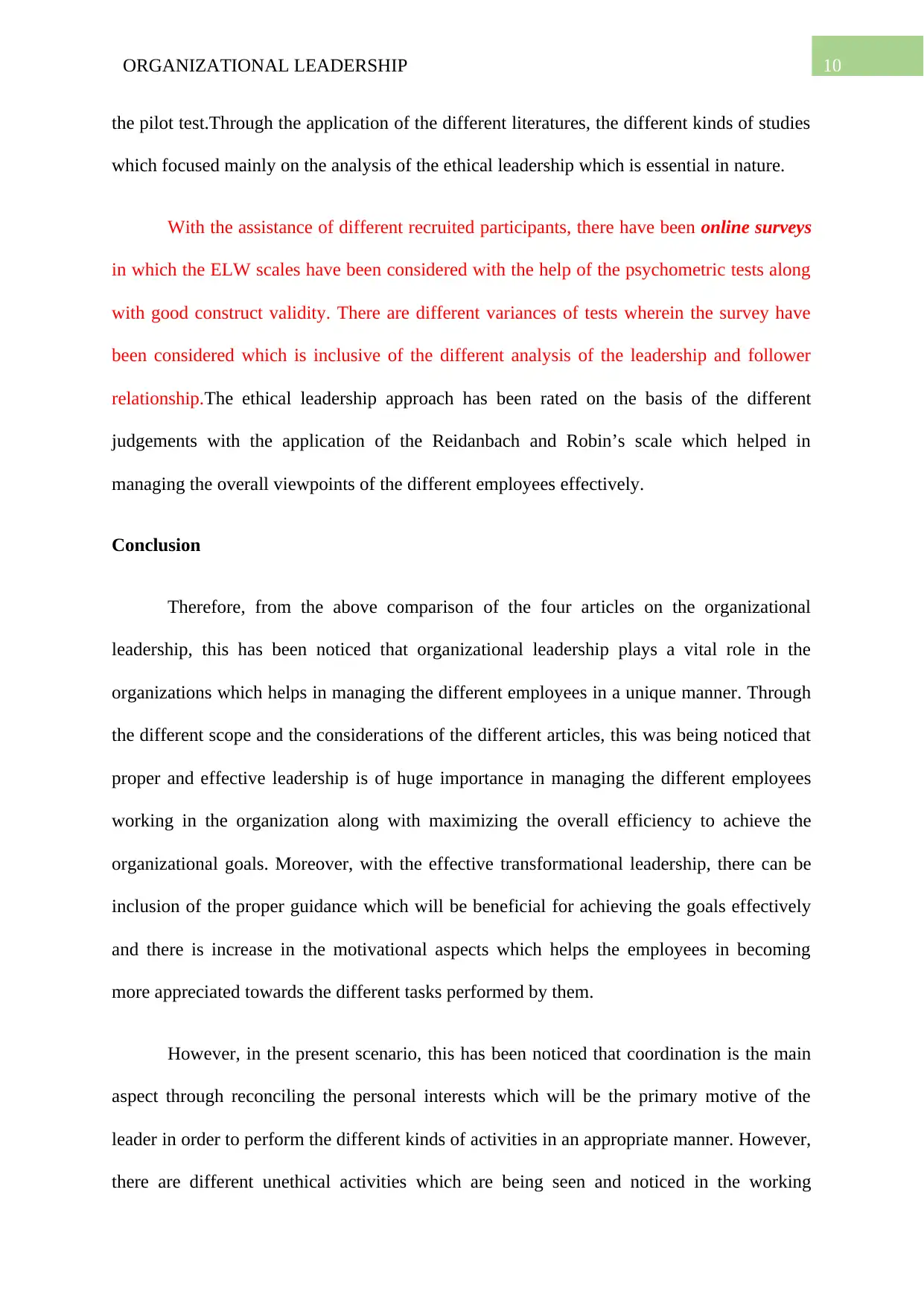
10ORGANIZATIONAL LEADERSHIP
the pilot test.Through the application of the different literatures, the different kinds of studies
which focused mainly on the analysis of the ethical leadership which is essential in nature.
With the assistance of different recruited participants, there have been online surveys
in which the ELW scales have been considered with the help of the psychometric tests along
with good construct validity. There are different variances of tests wherein the survey have
been considered which is inclusive of the different analysis of the leadership and follower
relationship.The ethical leadership approach has been rated on the basis of the different
judgements with the application of the Reidanbach and Robin’s scale which helped in
managing the overall viewpoints of the different employees effectively.
Conclusion
Therefore, from the above comparison of the four articles on the organizational
leadership, this has been noticed that organizational leadership plays a vital role in the
organizations which helps in managing the different employees in a unique manner. Through
the different scope and the considerations of the different articles, this was being noticed that
proper and effective leadership is of huge importance in managing the different employees
working in the organization along with maximizing the overall efficiency to achieve the
organizational goals. Moreover, with the effective transformational leadership, there can be
inclusion of the proper guidance which will be beneficial for achieving the goals effectively
and there is increase in the motivational aspects which helps the employees in becoming
more appreciated towards the different tasks performed by them.
However, in the present scenario, this has been noticed that coordination is the main
aspect through reconciling the personal interests which will be the primary motive of the
leader in order to perform the different kinds of activities in an appropriate manner. However,
there are different unethical activities which are being seen and noticed in the working
the pilot test.Through the application of the different literatures, the different kinds of studies
which focused mainly on the analysis of the ethical leadership which is essential in nature.
With the assistance of different recruited participants, there have been online surveys
in which the ELW scales have been considered with the help of the psychometric tests along
with good construct validity. There are different variances of tests wherein the survey have
been considered which is inclusive of the different analysis of the leadership and follower
relationship.The ethical leadership approach has been rated on the basis of the different
judgements with the application of the Reidanbach and Robin’s scale which helped in
managing the overall viewpoints of the different employees effectively.
Conclusion
Therefore, from the above comparison of the four articles on the organizational
leadership, this has been noticed that organizational leadership plays a vital role in the
organizations which helps in managing the different employees in a unique manner. Through
the different scope and the considerations of the different articles, this was being noticed that
proper and effective leadership is of huge importance in managing the different employees
working in the organization along with maximizing the overall efficiency to achieve the
organizational goals. Moreover, with the effective transformational leadership, there can be
inclusion of the proper guidance which will be beneficial for achieving the goals effectively
and there is increase in the motivational aspects which helps the employees in becoming
more appreciated towards the different tasks performed by them.
However, in the present scenario, this has been noticed that coordination is the main
aspect through reconciling the personal interests which will be the primary motive of the
leader in order to perform the different kinds of activities in an appropriate manner. However,
there are different unethical activities which are being seen and noticed in the working
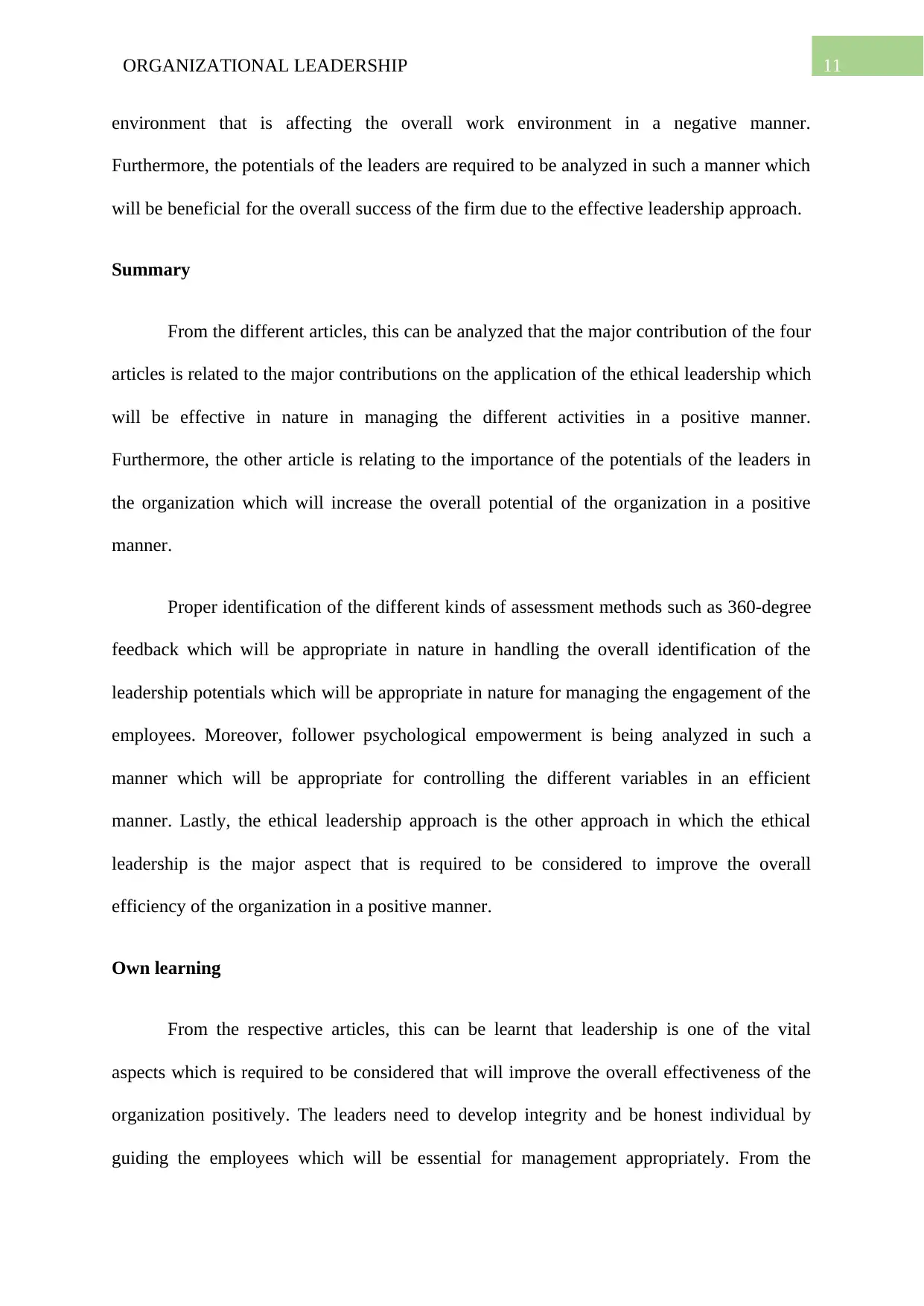
11ORGANIZATIONAL LEADERSHIP
environment that is affecting the overall work environment in a negative manner.
Furthermore, the potentials of the leaders are required to be analyzed in such a manner which
will be beneficial for the overall success of the firm due to the effective leadership approach.
Summary
From the different articles, this can be analyzed that the major contribution of the four
articles is related to the major contributions on the application of the ethical leadership which
will be effective in nature in managing the different activities in a positive manner.
Furthermore, the other article is relating to the importance of the potentials of the leaders in
the organization which will increase the overall potential of the organization in a positive
manner.
Proper identification of the different kinds of assessment methods such as 360-degree
feedback which will be appropriate in nature in handling the overall identification of the
leadership potentials which will be appropriate in nature for managing the engagement of the
employees. Moreover, follower psychological empowerment is being analyzed in such a
manner which will be appropriate for controlling the different variables in an efficient
manner. Lastly, the ethical leadership approach is the other approach in which the ethical
leadership is the major aspect that is required to be considered to improve the overall
efficiency of the organization in a positive manner.
Own learning
From the respective articles, this can be learnt that leadership is one of the vital
aspects which is required to be considered that will improve the overall effectiveness of the
organization positively. The leaders need to develop integrity and be honest individual by
guiding the employees which will be essential for management appropriately. From the
environment that is affecting the overall work environment in a negative manner.
Furthermore, the potentials of the leaders are required to be analyzed in such a manner which
will be beneficial for the overall success of the firm due to the effective leadership approach.
Summary
From the different articles, this can be analyzed that the major contribution of the four
articles is related to the major contributions on the application of the ethical leadership which
will be effective in nature in managing the different activities in a positive manner.
Furthermore, the other article is relating to the importance of the potentials of the leaders in
the organization which will increase the overall potential of the organization in a positive
manner.
Proper identification of the different kinds of assessment methods such as 360-degree
feedback which will be appropriate in nature in handling the overall identification of the
leadership potentials which will be appropriate in nature for managing the engagement of the
employees. Moreover, follower psychological empowerment is being analyzed in such a
manner which will be appropriate for controlling the different variables in an efficient
manner. Lastly, the ethical leadership approach is the other approach in which the ethical
leadership is the major aspect that is required to be considered to improve the overall
efficiency of the organization in a positive manner.
Own learning
From the respective articles, this can be learnt that leadership is one of the vital
aspects which is required to be considered that will improve the overall effectiveness of the
organization positively. The leaders need to develop integrity and be honest individual by
guiding the employees which will be essential for management appropriately. From the
⊘ This is a preview!⊘
Do you want full access?
Subscribe today to unlock all pages.

Trusted by 1+ million students worldwide
1 out of 17
Related Documents
Your All-in-One AI-Powered Toolkit for Academic Success.
+13062052269
info@desklib.com
Available 24*7 on WhatsApp / Email
![[object Object]](/_next/static/media/star-bottom.7253800d.svg)
Unlock your academic potential
Copyright © 2020–2025 A2Z Services. All Rights Reserved. Developed and managed by ZUCOL.





